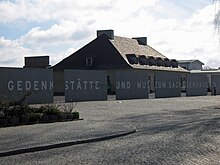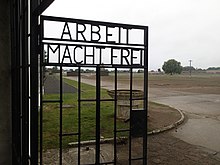Sachsenhausen Memorial and Museum
The Sachsenhausen Memorial and Museum is located on the site of the former Sachsenhausen concentration camp in Oranienburg , Brandenburg , north of Berlin . The facility sees itself as a place of remembrance and learning as well as a modern contemporary history museum . It follows a decentralized overall concept in order to make the history tangible for the visitor in the authentic places. In 13 exhibitions, the concrete history of the respective historical location is linked as a central idea with a further thematic presentation. The main topics range from the history of the Oranienburg concentration camp , various aspects of the history of the Sachsenhausen concentration camp to the Soviet special camp and the history of the memorial itself.
The Sachsenhausen Memorial and Museum is part of the Brandenburg Memorials Foundation, a public law foundation jointly financed by the Federal Republic of Germany and the State of Brandenburg.
Development of the memorial and museum
Since the 1990s there have been heated debates in Oranienburg over the question of how a balanced relationship can be achieved between the presentation of the history of the National Socialist concentration camp and the Soviet special camp. When the special camp museum opened in August 2001, there were indignant reactions. An official statement from the Russian Foreign Ministry claimed that the museum "placed the crimes of fascism and the actions of the Soviet occupying forces on an equal footing". On the other hand, the victims' associations of the special camp warned against "playing down the NKVD camp and the inhuman conditions of detention".
As part of the complete renovation and redesign of the Sachsenhausen memorial, the place of remembrance received a new face. At the end of 2001, the Sachsenhausen Memorial opened a new permanent exhibition on the history of the Soviet special camp No. 7 / No. 1 (1945-1950). In 2004, a permanent exhibition on the subject of "Medicine and Crime" was opened in the originally preserved barracks RI and R II, with 800 m² and around 100 exhibits the largest within the memorial. The renovation work was largely completed for the celebrations to mark the 60th anniversary of the liberation in April 2005. The overall concept of the Sachsenhausen memorial was created by hg merz architects and museum designers .
Exhibitions
The Sachsenhausen Memorial and Museum pursues a decentralized exhibition concept. In addition to various special and traveling exhibitions, there are the following permanent exhibitions:
- Oranienburg concentration camp 1933–1934
- The SS Concentration Camp 1936 to 1945: Division of labor in Sachsenhausen concentration camp
- Jewish prisoners in Sachsenhausen concentration camp from 1936 to 1945
- The "everyday life" of the inmates of the Sachsenhausen concentration camp from 1936 to 1945
- Medicine and crime. The infirmary of the Sachsenhausen concentration camp 1936–1945
- The cell construction of the Sachsenhausen concentration camp 1936–1945
- Sachsenhausen Concentration Camp 1936–1945. Events and developments
- Murder and mass murder in Sachsenhausen concentration camp 1936–1945
- The headquarters of the concentration camp terror. The inspection of the concentration camps 1934–1945
- Concentration camp external camp "Klinkerwerk"
- Soviet special camp No. 7 / No. 1 (1945-1950)
- From memory to monument. The history of the Sachsenhausen National Memorial, 1950–1990
Various tours are offered, from overview tours to thematic group tours and individual tours. But visiting the memorial and the exhibitions is also possible without a guided tour.
The death march memorial in the Belower Forest forms a branch .
The special camp No. 7 / No. 1 Sachsenhausen

After important files on the special camp became accessible again and those affected and their relatives reported, investigations into the time of the special camp began. Outside the actual camp (adjacent to the north and in the forest towards Schmachtenhagen ), 28 mass graves were identified and found next to the grave of Heinrich George in March 1990 with the help of the former camp chimney sweep Oels . During his internment, which lasted from 1945 to 1948, he was able to observe their excavation from the roofs. Since the camp was still active until 1950, further mass graves that have not yet been discovered are likely. The camp itself was largely demolished immediately after its dissolution. Since the later establishment of the Sachsenhausen National Memorial and Memorial in the GDR was mainly dedicated to the victims of fascism for political reasons , only a few finds (including the renovation of the memorial after 2000) were made from the time of the special camp.
At the northern tip of the memorial site, at the interface between the former camp zones I and II, the Museum of the History of Special Camp No. 7 / No. 1 opened, in the immediate vicinity of the largest mass cemetery "Am Kommandantenhof". On 350 m², visitors are informed about the history, structure and organization as well as the topography of the special camp. The prisoner society of the special camp is presented on the basis of 27 biographies, the exhibition also goes into the extreme prison conditions and dying as well as death.
The Sachsenhausen Memorial and Museum also maintains a scientific section "Soviet Special Camp", which is dedicated to research, collection and publication on the history of Special Camp No. 7 / No. 1 dedicates. The association Childhood Behind Barbed Wire e. V. with the collection of those affected, the research and processing of the children's fates in the Sachsenhausen special camp.
Memory of individual groups of victims
In 2006, the Berlin Cardinal Georg Sterzinsky had a memorial stone by the Berlin sculptors Stefan Sprenker and Thomas Reifferscheid erected on the grounds of the Sachsenhausen concentration camp for the more than 700 imprisoned Catholic clergy. The names of the 96 clergymen who died in Sachsenhausen and who came from several European countries are recorded on the stone. Since 2006 there has also been a memorial for the Protestant prisoners in Sachsenhausen.
History of the memorial
Sachsenhausen national memorial in the GDR
After the use of the site by the Soviet army ( Sachsenhausen special camp until 1950) and the barracked People's Police , planning began in the GDR in 1956 for the Sachsenhausen National Memorial . In 1955, a donation stamp sale by the Board of Trustees for the establishment of national memorials raised two million marks in a short time. The landscape and garden architect Reinhold Lingner and the architects Ludwig Deiters , Horst Kutzat and Kurt Tausendschön were involved in the planning. René Graetz created the sculpture “Liberation”. In 1961, the sculpture was "the accuser" of Fritz Cremer at Oranienburg Palace erected.
On April 22, 1961, the national memorial and memorial was ceremoniously opened. The designs for the hall come from Ludwig Deiters and Horst Kutzat. The garden architects Hubert Matthes and Hugo Namslauer designed the green area . In the hall there is a bronze sculpture depicting three figures that are supposed to symbolize resistance / awareness of victory, grief and death. This was created by Professor Waldemar Grzimek .
The memorial was limited to the area of the former prisoner camp and only covered around five percent of the area of the former concentration camp. Only “Station Z” and the firing trench, originally part of the industrial courtyard, were integrated into the memorial by relocating the camp wall. A semicircular wall made of cross-shaped concrete elements was built around the roll call square, in which the gables of the first ring of the barracks are indicated.
Most of the entire former camp area was demolished, reforested, used as barracks by the Soviet Army and the National People's Army of the GDR, released for residential and commercial purposes or continued to be used or fell into disrepair. In 1976, 200 uniform boards were set up on the four main routes of the death march between Oranienburg and Raben-Steinfeld. Until the turn of 1989, the memorial was the destination of thousands of school classes from the GDR, delegations from Germany and abroad as well as the venue for sporting, political and military events (swearing-in ceremonies, etc.).
Arson attacks in 1992
On September 26, 1992 neo-Nazis set fire to Barrack 38 in the memorial of the former Sachsenhausen concentration camp. The building that housed a “Museum for the Sorrows of Jewish Comrades” was destroyed. The attack took place ten days after the visit of then Israeli Prime Minister Yitzchak Rabin on the night before the Jewish New Year celebration of Rosh Hashanah . Two of the perpetrators were identified and sentenced to prison terms in 1995.
Special exhibitions
Sculptures on the way from Oranienburg train station to the memorial in 1997
In 1997, an exhibition of sculptures by the Berlin artist Stuart NR Wolfe on the way from the Oranienburg train station to the memorial led to heated discussions in the city . These were damaged by neo-Nazis a few days after they were set up, and the city of Oranienburg then wanted to have them removed. Only after protests by the Brandenburg Memorials Foundation did the sculptures return to public space after being repaired.
Special exhibition "BitterSüß" 2005–2006
On the 60th anniversary of the establishment of the Soviet special camp No. 7 / No. 1 Sachsenhausen a special exhibition was opened in the new museum (August 12, 2005 to August 31, 2006): BitterSüß, history (s) of hunger: sugar bowls from the Soviet special camp No. 7 / No. 1 Sachsenhausen 1945–1950 .
During renovation work at the Sachsenhausen Memorial, numerous small aluminum cans were recovered in previous years. For the first time, an exhibition was devoted in detail to these everyday objects, which many prisoners in the Soviet special camp used to store sugar and jam rations from 1947 onwards.
They document central aspects of everyday prison life in the special camp: malnutrition and mass starvation , but also human isolation and forced inactivity. Some sugar bowls have their owners' names engraved on them. The exhibition told the life stories of 16 former prisoners from the special camp, whose cans came to light again after more than 50 years. The biographies with their different historical and political backgrounds indicate the heterogeneity of the prisoner society.
Web links
Individual evidence
- ↑ since 1993 memorial and museum Sachsenhausen. 2018, accessed December 31, 2018 .
- ↑ Petra Haustein: History in Dissent - The disputes about the Sachsenhausen memorial after the end of the GDR. Leipziger Universitätsverlag, Leipzig 2006.
- ↑ Eckart Roloff , Karin Henke-Wendt: Where doctors became criminals. (Museum “The sick bay of Sachsenhausen concentration camp”) In: Visit your doctor or pharmacist. A tour through Germany's museums for medicine and pharmacy. Volume 1: Northern Germany. Verlag S. Hirzel, Stuttgart 2015, ISBN 978-3-7776-2510-2 , pp. 48-50.
- ↑ permanent exhibitions. In: sachsenhausen-sbg.de. 2018, accessed December 31, 2018 .
- ^ Günter Morsch: Foreword . In: Günter Morsch; Ines Reich (Ed.): Soviet Special Camp No. 7 / No. 1 in Sachsenhausen (1945 - 1950): Catalog of the exhibition in the Sachsenhausen Memorial and Museum = Soviet Special Camp No. 7 / No. 1 in Sachsenhausen (1945-1950) . 1st edition. Metropol, Berlin 2005, ISBN 978-3-938690-13-0 , pp. 14th f .
- ↑ "Those affected have been meeting regularly since 1997, researching and comparing their previously invisible early childhood together." Born behind bars. Children's fates in the post-war period. Film by Hans-Dieter Rutsch ( memento from September 29, 2016 in the Internet Archive ). In: phoenix.de. Phoenix , September 25, 2016, accessed December 28, 2017 (movie description).
- ↑ Horst Kutzat: Memorial Hall in the National Memorial and Memorial Sachsenhausen. In: German architecture. Issue 5, year 1962, p. 279.
- ↑ a b Ralph Gabriel. Ingo Grastorf, Tanja Lakeit, Lisa Wandt, David Weyand: Futur Exakt - youth culture in Oranienburg between right-wing extremist violence and democratic engagement . In: Hajo Funke (ed.): Series of publications on politics and culture . tape 6 . Verlag Hans Schiler, Berlin 2004, ISBN 3-89930-074-2 , p. 57 .






